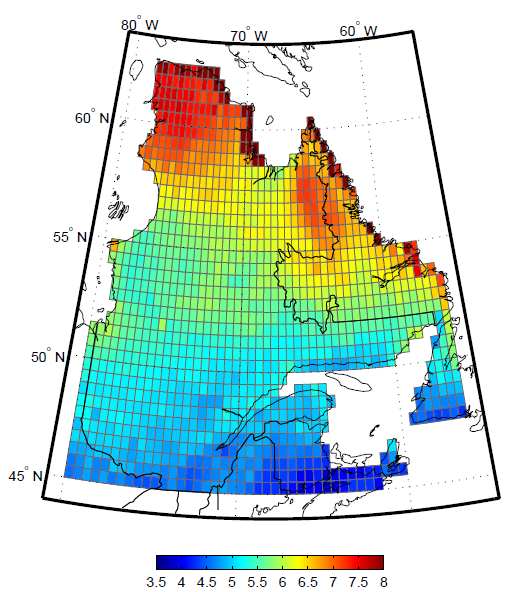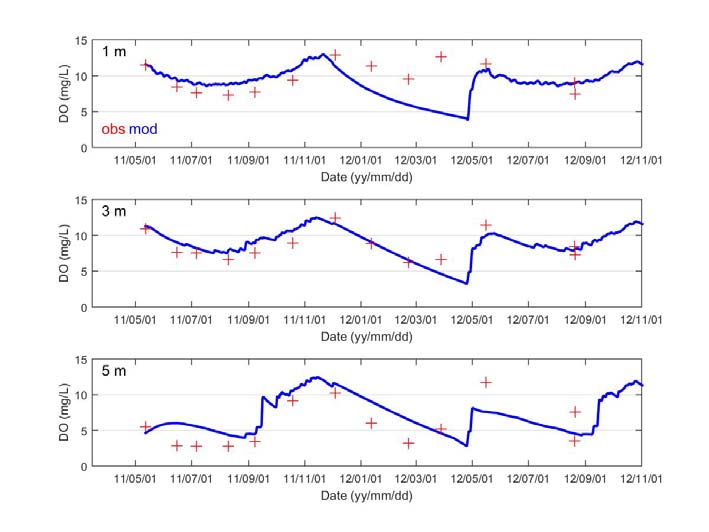Mapping the Impacts of Climate Change on Salmonid habitat in the Northern Lakes of Québec
The mapping tool and model developed will better equip MFFP fisheries managers to evaluate salmonid habitats quality in Québec’s northern lakes and thereby prioritize actions to adapt their resource management measures according to the response of the fish habitats to climate change, based notably on changes in temperature and dissolved oxygen in the lakes.
Project details
Principal(s) investigator(s)

Context
There are a great number of northern lakes at latitudes where climate change is already apparent. These aquatic ecosystems are expected to undergo significant changes over the coming decades, including the possible degradation of salmonid (char, trout, lake trout and salmon) habitat.
Fish in the salmonid family have significant commercial, social and cultural value and support recreational and subsistence fishing that generates significant economic benefits for Québec. In 2012, revenues from salmonid fishing amounted to $482 million, or close to 44 % of total spending on recreational fishing in Québec. Salmonid populations are very closely monitored, and it is essential for fisheries managers to know which lakes are the most vulnerable and where to concentrate their efforts in order to adapt their resource management measures accordingly.
Following an initial study that demonstrated how and by what process climate change influences the warming of lakes, this new project focused on temperature and dissolved oxygen content, the two main physicochemical variables that characterize the preferred habitat of salmonid species, which have strict threshold temperatures and oxygen levels for growth and reproduction.
Photo : SÉPAQ
Objective(s)
Quantify, at a regional level, future changes in water temperature and dissolved oxygen concentration in northern lakes (located above 50°N) in Québec and Nunavik along a south-north gradient.
Methodology
-
Measure water temperature and dissolved oxygen concentration in selected lakes to calibrate the one-dimensional MyLake model.
-
Simulate the annual temperature cycle at different water depths for the reference period (1981-2010) using observation-based reanalysis and for 2041-2070 and 2071-2100 using the delta method.
-
Add a new module to the MyLake model to simulate the sources, losses and annual cycle of dissolved oxygen content at different water column depths.
Results
A method for classifying Québec lakes was developed based on morphometric parameters (surface, perimeter, mean depth, lake position and meteorological data) provided by the Ministère des Forêts, de la Faune et des Parcs and Environment and Climate Change Canada.
This classification was done in two stages, involving principal component analysis and an ascending hierarchical classification. Based on a selection of 27,846 lakes from the initial database, the analysis led to a classification comprising 11 standard lake types and showed that 75 % of the regions under study could be characterized by a single type of lake.
Thermal habitat maps for the 1981-2010 (reference), 2041-2070 and 2071-2100 horizons were produced using the one-dimensional MyLake model (Figure 1). Daily variations in water temperature dissolved oxygen content and dissolved organic carbon content were modelled for three test lakes: Jacques-Cartier (in southern Québec), Simoncouche (in the Saguenay) and Stewart (near Kuujjuaq, Nunavik). Observed daily variations show that the model provides a good representation of temperature variations.

Figure 1: Increase in summer water temperature of the surface five first metres between 1981-2010 and 2071-2100.
Modelling dissolved oxygen posed a real challenge during this project; it is encouraging to note that the model simulates annual variation in dissolved oxygen in the water column quite well. However, the simulation is less accurate close to the lake surface and bottom, where exchange processes not taken into account by the model influence dissolved oxygen levels (Figure 2).

Figure 2: Simulated (blue line) and measured (red crosses) dissolved oxygen content over an 18-month period.
Indicators such as maximum heat content, maximum ice cover thickness, the number of days with at least 25 % of lake volume between 5°C and 15°C (thermal refuge) and the number of days with temperatures exceeding the upper water temperature threshold across the entire volume of the lake, were designed to map the spatial variation of the intensity and duration of heat stress experienced by salmonids in summer and the conditions conducive to their growth and productivity.
The tool will be improved by completing the simulations of dissolved oxygen content for the test lakes and producing maps of oxic habitat health indicators for test lakes in each administrative region of Québec, including Nunavik.
Benefits for adaptation
Benefits for adaptation
Using the lake classification method developed in this project, it is now possible to identify a single type of lake per administrative region in Québec and project how these lakes will respond to the changes in climate expected by the end of the century.
The mapping tool and model developed will better equip MFFP fisheries managers to evaluate salmonid habitats quality in Québec’s northern lakes and thereby prioritize actions to adapt their resource management measures according to the response of the fish habitats to climate change, based notably on changes in temperature and dissolved oxygen in the lakes.
Scientific publications
Funding




Other participants
-
Ministère des Forêts, de la Faune et des Parcs
-
Norsk Institute for Vannforskning
-
Université du Québec à Chicoutimi